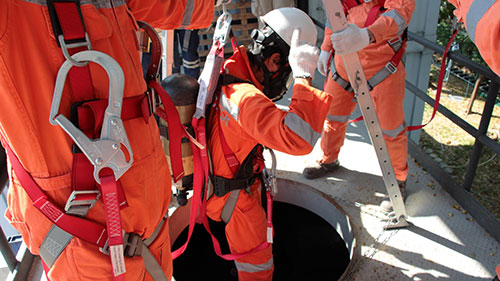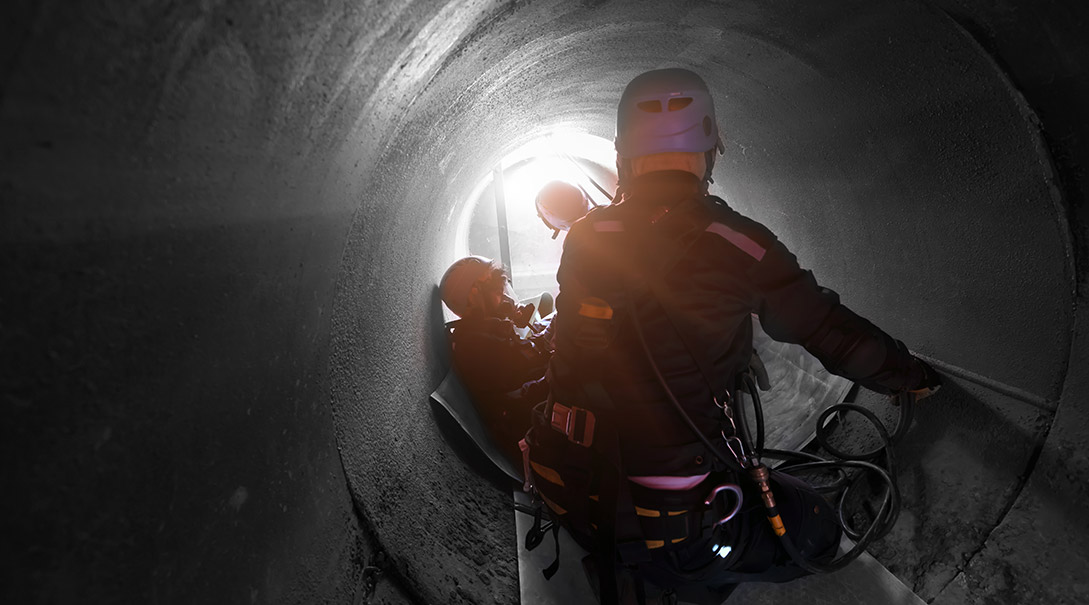Table of Contents
Understanding Confined Space Training and Why It’s Important to Your Business
What are the safety concerns when a worker enters a pipeline, tank, underground vault, pit, process vessel, manhole, silo, storage bin, or similar environment? Answering that question is central to confined spaces training.
Our training guide covers the key points of this essential occupational health and safety topic:
- What is a Confined Space?
- What is a Permit-Required Confined Space?
- What is Confined Spaces Training?
- Confined Spaces Training Requirements
- Is Confined Spaces Training Mandatory?
- How Often is Confined Spaces Training Required?
- Key Course Objectives
What is a Confined Space?
To understand what a confined space is, we can look to the Occupational Safety and Health Administration (OSHA). OSHA’s General Industry and Construction regulations state that this type of space has these three characteristics:
- Is of sufficient size and designed in such a way that workers can physically enter and conduct tasks;
- Has entrances/exits that are restricted or limited; and
- Has a configuration that does not allow for workers to occupy the space continually.
Examples that OSHA provides for these types of spaces include the following:
- Hoppers
- Pits
- Silos
- Storage bins
- Tanks
- Vaults
- Vessels.
What Is A Permit-Required Confined Space?

A permit-required confined space meets one or more of the following four characteristics:
- Is designed in such a way that either the floor has a downward slope leading into a smaller area or the walls converge toward one another, creating the danger of entrant asphyxiation or entrapment;
- Either has an atmospheric hazard or has the potential to contain one;
- Has a substance in which an entrant could become submerged; and/or
- Has significant health or safety hazards beyond those described above.
What Is Confined Spaces Training?
Confined spaces training is an instructional course on confined spaces. It allows employees who work in or near these spaces to stay safe. It is also a compliance effort that helps an organization protect itself legally and financially.
These training programs help workers take OSHA standards and apply them to appropriate situations. Key elements of OSHA confined spaces training include (but are not limited to) answering the following questions:
- How do you determine what qualifies as a confined space?
- What makes a confined space “permit-required”?
- For what scenarios are reclassification and alternate entry procedures acceptable?
- What are the agency’s rules for permit space entry program creation and maintenance?
- What do you need to have in place for emergency and rescue?
- What must entry supervisors, attendants, entrants, and contractors do related to confined spaces?
- How can you utilize relevant equipment?
- How can equipment not be used?
By addressing the above questions and others, providing OSHA confined spaces training helps your workers understand the biological, chemical, and physical aspects of maintaining safety.
Confined Spaces Training Requirements

There must be a training program in place that educates workers who have job activities near or within confined spaces. Training ensures they have the necessary understanding to protect themselves and others.
Workers must get the training at all of the following times:
- prior to performing any confined-spaces-related duties
- if and when it becomes clear that a worker does not completely grasp confined spaces safety
- if and when an employer determines that their personnel are noncompliant with their confined spaces procedures
- prior to adjustments of any employee tasks related to these areas
- if and when hazards that have not been covered in past training arise because of permit space operation changes.
An employer should perform OSHA confined spaces training certification to determine that training occurs in all the above scenarios. The training program must ensure that workers are competent in all aspects of confined space safety. The employer must adjust their confined spaces activities to maintain compliance (based on any issues revealed during training).
OSHA confined spaces training certification must be performed to verify the completion of the program by all workers who come into contact with these spaces. Each employee’s name must be contained within the certification, along with training dates and the trainer’s signature (or initials). Both employees and anyone authorized to represent them must have access to these certifications as desired.
A separate aspect of OSHA compliance that needs to occur before training is that you need to create procedures related to confined spaces; that way, you can train using them as a basis. Plus, you must create and put into place rescue and emergency services – which involves designating those individuals who are authorized to perform a rescue from confined spaces and perform the emergency treatment. These individuals must be appropriately trained as to how to conduct these services safely and effectively.
Rescue and emergency individuals must be trained on how to use the personal protective equipment (PPE) to which they are entitled under the OSHA regulations. They must be trained on how to perform rescues. They must also be instructed in cardiopulmonary resuscitation (CPR) and basic first aid. At least one individual must hold certification in CPR and first aid on the rescue and emergency team.
Authorized entrants to confined spaces must know the following:
- Any hazards they could encounter.
- What could happen medically if they are exposed to hazards.
- Proper use of PPE, as well as appropriate use of equipment for ventilation, testing/monitoring, communications, shields/barriers, lighting, and entry/exit (e.g., ladders).
- Proper communication with the attendant, so the attendant knows when they are within the space, if they become exposed to a hazard, or if they identify a problem; and
- When to evacuate, whether it’s because of an entry supervisor’s or attendant’s order, the sounding of an alarm, or because they personally see a hazardous scenario arising.
Additional information is needed for the training of attendants and entry supervisors, as described within Section 1910.146.
Is Confined Spaces Training Mandatory?
Yes. OSHA mandates that training be provided to affected employees.
How Often Is Confined Spaces Training Required?
OSHA does not establish how often this training must recur. Typically, specialists in the industry suggest instruction be performed annually or biannually.
You do need to make sure two related activities occur every twelve months:
- Reassessment of the permit space program; and
- A practice rescue drill by those designated for rescue duties.
What Happens If You Don’t Get Confined Space Training?
Failing to comply with confined space training requirements can lead to stringent penalties and significant financial implications for businesses. For example, under OSHA regulations, serious violations can result in fines of up to $14,502 per violation. Even more severe consequences can arise from willful or repeated violations, with fines reaching up to $145,027 per violation. These are not just theoretical numbers; companies across various industries have faced such penalties.
In a notable case, an Illinois grain facility faced fines exceeding $200,000 after exposing employees to unsafe conditions in a confined space, highlighting the grave financial and human costs of inadequate safety practices.
These examples underscore the tangible risks and repercussions of neglecting confined space training. Beyond financial penalties, the indirect costs of such incidents — including increased insurance premiums, legal fees, and potential compensation claims — can further escalate the financial burden on businesses. Moreover, the reputational damage and loss of trust from employees and the public can have long-lasting impacts on a company’s success and sustainability.
Key Course Objectives
The primary goal of the course of your confined space should be that participants walk away with the following knowledge:
- How a confined space (CS) is defined
- How a permit-required confined space (PRCS) is defined and recognized
- How a non-permit confined space (NPCS) is defined and recognized
- The different confined space entry roles, along with applicable responsibilities
- The various types of confined space hazards, as well as appropriate responses
- Emergency rescue protocols and chain-of-command
- Personal protective equipment (PPE) needed for confined space entry
- Additional equipment that is potentially necessary for confined space entry.
Confined Spaces Training You Can Trust
Do you need confined spaces training for your company? At AOTC, our staff has extensive experience providing compliance training services to a range of clients across a spectrum of industries. Contact us for a customized, on-site confined space training program to ensure your company is protected.
